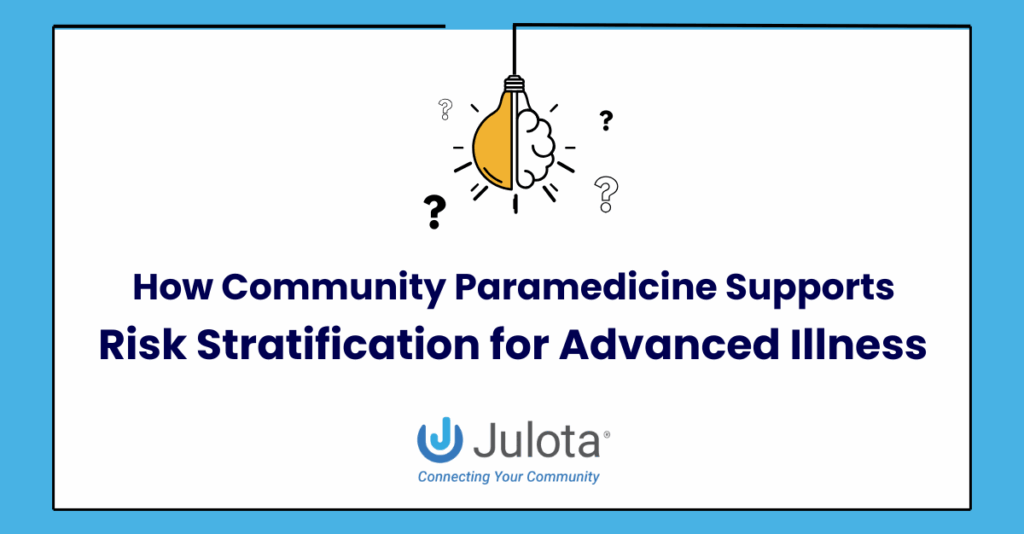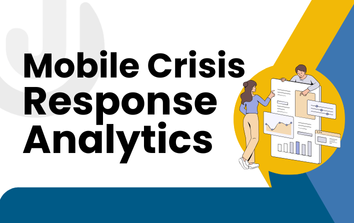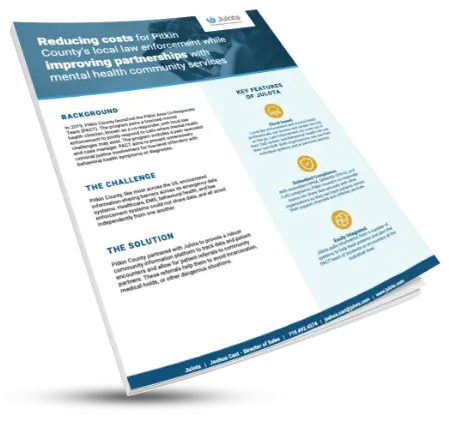What if you could put a percentage on how likely someone is to have a heart attack? And then what if you could work to lower that percentage to maximize quality of life? That’s what risk stratification does. Here, we examine how community paramedicine supports risk stratification for individuals with advanced illness and chronic disease.
Risk stratification is the process of assigning a likelihood of a specific outcome to a given condition. For example, how likely is a person who has just had heart surgery to have a heart attack? Community paramedics support risk stratification by assessing individuals in the field, gathering frequent data points, and reporting their findings to the attending physician.

How Community Paramedicine Improves Risk Stratification
Risk stratification can be employed in various ways and serve multiple objectives. For example, consider risk stratification before a person undergoes surgery. What is the likelihood that the patient will have a good outcome and recovery following the surgery? A person in their fifties is much more likely to be a good candidate for hip surgery than a person in their nineties; however, age is not the only factor in risk stratification (though it is part of it).
Along with medical procedures and surgery, there’s also risk stratification related to health conditions. For example, risk stratification might ask: How likely is someone with congestive heart failure to be readmitted to the hospital within the next year?
And then there is risk stratification that looks at cost rather than specific health outcomes. In these instances, the question is: what expenses is a person likely to encounter over the course of a health condition? What is their trajectory?
These are some of the questions posed during the risk stratification process. As it happens, community paramedicine is well-positioned to aid in risk stratification, which is what we will outline in the following sections.
Here are some ways MIH Community Paramedicine supports Risk stratification:
- How Risk Stratification Can Work with Community Paramedicine (Delivering Preventative Care)
- Community Paramedicine Can Add Data Points (Fall Risks, Home Environment)
- Checking for Blood Pressure and Vitals in the Field
- Identifying Recent 911 Calls and Frequent ER Visits
- Taking Into Account Mental Health Events
In the following sections, we’ll provide the details you need to understand how community paramedicine can play a role in risk stratification. Specifically, we’ll examine the information that community paramedics can gather to assess an individual’s health risks.
How Risk Stratification Can Work with Community Paramedicine (Delivering Preventative Care)
One of the key considerations is that community paramedicine can support individuals who are at a higher risk of developing certain health conditions. For example, a person who has just been released from the hospital after hip surgery can be followed up with by community paramedics to ensure their vitals are stable, their home environment is conducive to healing, and that they don’t experience any relapses during recovery.
In other words, community paramedics can both support the collection of data regarding a person’s risk and assist those identified as being at high risk.
One of the inherent limitations of risk stratification in clinic-based healthcare is the inability to see the patient’s home environment. And that’s where community paramedics become the authentic secret sauce of accurate risk stratification.
Community paramedics can add many data points that the clinic would never otherwise reliably gather. Below, we’ll discuss these critical data points in more detail and explore how community paramedics gather them.
Risk Stratification and Mobile Integrated Health: Community Paramedicine Can Add Data Points (Fall Risks, Home Environment)
One way Mobile Integrated Healthcare can support risk stratification is by examining aspects that traditional clinics cannot. We mentioned in the last section that community paramedics can enter a patient’s home and gather a wealth of information that is often left out of a person’s healthcare picture.
One central area is fall risks. A primary care physician can assign a person a specific level of fall risk based on their clinical presentation during the office visit. Still, they cannot enter a person’s home to assess if any glaring environmental dangers will increase their patient’s risk of falling.
For example, a physician bound to a clinic may not notice that someone has slippery rugs in their kitchen, broken steps leading up to their porch, no access to a ramp, or no railings in a person’s bathroom. All these data points will change someone’s risk stratification for injuries related to falls.
But falls aren’t the only type of risk that community paramedics can assess, they can also evaluate other potential dangers such the air quality (which can be a significant factor for those with potential lung diseases), location to the hospital (how far away someone lives from hospitals can relate to their health), and what kind of social structure they have in place (those will fewer friends and family supporting them can have higher risk for certain diseases).
Community Paramedics Support Risk Stratification by Checking for Blood Pressure and Vitals in the Field (Looking for Trends)
It’s not difficult to assign someone a risk for a particular illness; however, it is difficult to assign them a risk accurately, and it’s even more challenging to update that risk as the person’s life changes (for better or worse).
One way community paramedics support risk stratification is by regularly collecting vital signs from the people they serve. The community paramedics can report the vitals back to the primary care physician, who can then get a better picture of what’s going on.
Instead of the doctor taking a person’s vitals every couple of months, they can look at someone’s vitals every couple of weeks or even days (depending on the level of care provided). One of the advantages of the vitals taken by a community paramedic is that they are “real-world” vitals measured in the person’s home environment.
This means that there is a lower risk of “white coat syndrome,” where a person’s vitals may be altered due to slight anxiety about being at the doctor’s office. In some cases, the person’s vitals may be better than people initially expected.
Regardless, the idea is that community paramedics provide a more accurate and up-to-date set of vitals that can better help place a person in the proper category during risk stratification.
Now, let’s discuss another data point that can be a determining factor in someone’s health: ER visits.
Risk Stratification and Mobile Integrated Health: Recent 911 Calls and Frequent ER Visits
Think of community paramedicine as the missing link in healthcare. What do we mean by that? Just consider 911 calls. We would probably assume that if a person calls 911 several times in a month for trouble breathing, that information should be included in their general health record and used to assign them a specific health risk.
The problem is, what if that patient didn’t go to the hospital every time they called 911? And what if, when they went to the hospital, they went to different ERs each time (this is more common than people might assume)? In these instances, the patient experienced a significant health event, but the providers responsible for their long-term care might not be aware that anything had changed.
That’s where Mobile Integrated Health comes into play. A team of community paramedics can provide a bridge between the out-of-hospital and in-hospital environments. If a person calls 911, regardless of the issue, it is documented in their health file, and their primary physician is notified.
To accomplish this seamless transfer of information, community paramedics use tools like Julota to gather and easily share data across platforms.
Taking Into Account Mental Health Events
Another way that community paramedics can support risk stratification for advanced illness is by taking into account mental health events in a person’s life. In some cases, mental healthcare and physician healthcare are kept separate – this is usually a bad idea.
If someone is struggling with severe depression or has been having suicidal ideations, this will have a direct impact on their physical health. However, if someone’s cardiologist doesn’t know that a person has been struggling with depression, they will fail to account for this in their treatment plan.
Community paramedics can provide this information. Often, community paramedics will work with co-responder teams or Crisis Intervention Teams, which are special units that will respond to people in the field when they are experiencing a negative mental health or psychiatric event. They can then provide this information to the health record, improving the accuracy of their risk stratification model.
Key Points: Community Paramedics and How They Support Risk Stratification
Community paramedics support risk stratification for various diseases by creating a bridge between the hospital and the home. Community paramedics can monitor vital signs, assess a person’s home environment, and incorporate mental health into a person’s overall health picture.
One way community paramedics can accomplish this is by utilizing the right tools. Contact Julota for more information on how their software can create a seamless connection between community paramedics and primary care providers.
Author
-

Noah Weinberg is a Marketing Associate at Julota, where he focuses on elevating the alternative response space, specifically Mobile Integrated Healthcare (MIH), Community Paramedicine, and co-responder models. He writes about the intersection of law enforcement, healthcare, and community well-being, drawing on real-world experiences with community paramedicine programs in Ontario, Canada.




